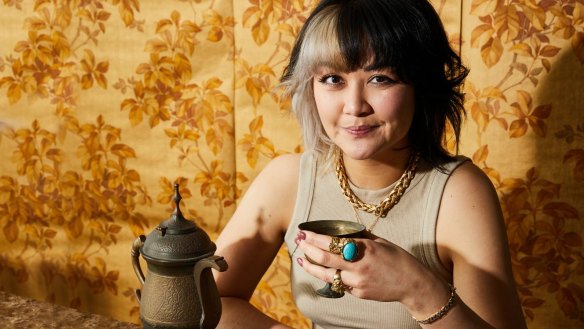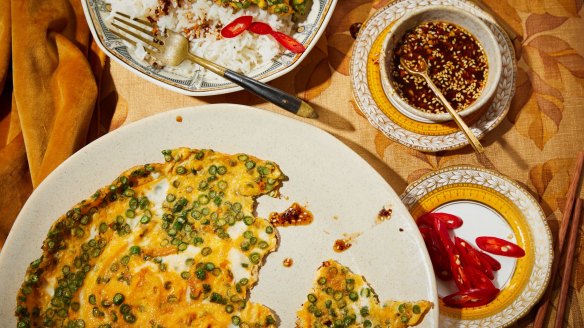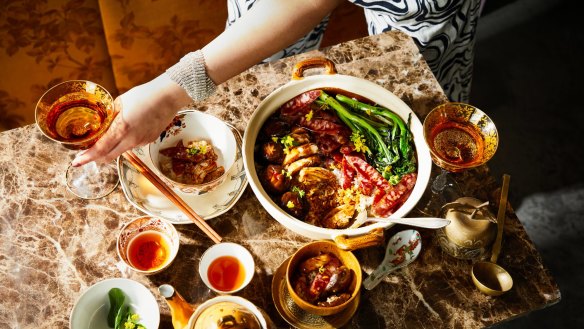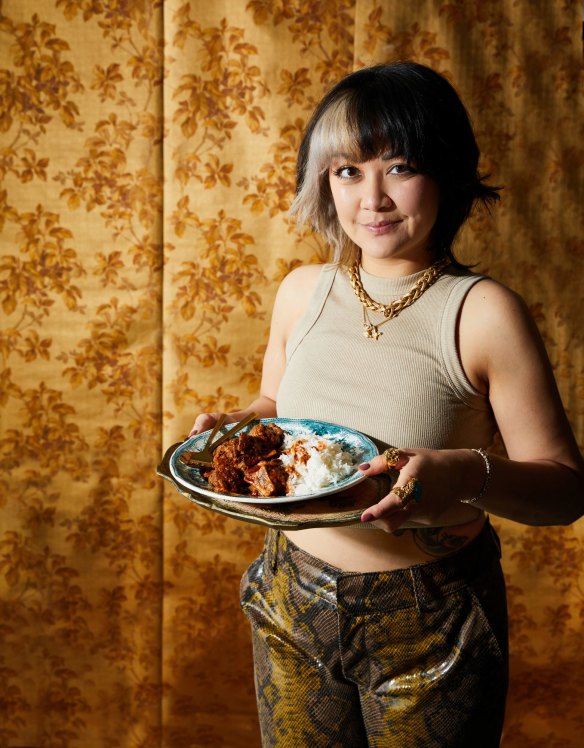Going for gold: Chef Rosheen Kaul on the many flavours of home

- Rosheen Kaul's recipes for rogan josh, green bean omelette and claypot rice
- Six delicious recipes from Rosheen Kaul's cookbook Chinese-ish
Good Food is thrilled to welcome Rosheen Kaul to our team of recipe columnists, which includes Karen Martini, Adam Liaw, Danielle Alvarez, Julia Busuttil Nishimura, Katrina Meynink and Helen Goh.
Originally from Singapore, 30-year-old Kaul is head chef at one of Melbourne's best restaurants, Etta in Brunswick. Kaul was born to parents of mixed Asian heritage (Kashmiri, Peranakan Chinese, Filipino) and she grew up moving between Australia, Malaysia, China and Indonesia.
She honed her cooking skills at prestigious Melbourne restaurants such as Dinner by Heston Blumenthal, Ezard and Lee Ho Fook.
At Etta, she combines her Asian heritage, training and sensibility on a menu that epitomises where dining is at right now – a new type of fusion that blends a multicultural heritage with a strong sense of being Australian.
Earlier this year she released a cookbook, Chinese-ish (with illustrator Joanna Hu), a snapshot of their journey as young Asian Australians navigating their culture through food.
I love this line from the cookbook's introduction: "This is our Chinese-ish story – vibrant, crispy, tasty, colourful and incredibly delicious. This is a book as modern and unconventional as we are."
We can't wait to take readers on this exciting flavour journey with Kaul
–Ardyn Bernoth, Editor
What does home taste like? For Rosheen Kaul, home tastes like a rich heritage of Singaporean and Kashmiri food, and the city and country she grew up in.
So many weekends of my life have been spent in markets with my family. We'd trawl through supermarkets, shops and stalls in Australia or in whichever country my dad was working in at the time with a very specific purpose – finding the right fruit or vegetables for dishes that would fill the house with the familiar flavours and smells of home.
Carefully searching for the greenest stems on shiny purple Lebanese eggplants, my dad would reminisce about the baby pink and white eggplants they'd use to make tschok wangun (eggplant in tangy gravy) in Kashmir.
"These smaller ones are fine," he'd say, "but you can't use regular thick eggplants. They need to be nice and slim." We'd find fat green kohlrabi bulbs in the market, but often scalped of their leafy tops.
As a chef, I am so privileged to contribute to the conversation of what Australian cuisine was, is and can become.
Without them, dad says that monji haak – a simple dish of braised kohlrabi greens with mustard oil, asafoetida and a whole chilli – could never be as delicious.
I've learnt my Kashmiri heritage through food, along with the skill of selecting the best produce for each specific dish. Through our market shops, dad taught me to look for smaller Asian leafy greens, so much sweeter and more tender when harvested young.
When buying chillies, I found that the curlier the shape, the spicier they are, and so to be careful when selecting chillies for heat versus for flavour. We'd walk past uniformly arranged morel mushrooms at fancy gourmet stores and he'd tell stories of farmers bringing sacks to their home in Srinagar overflowing with plump morels.

The Kashmir Valley is somewhat isolated and bound by the Himalayas, a region where you feel the full breadth of the seasons. Bitterly cold winters give way to spring, the hills and orchards alive with bright purple saffron flowers, stone fruit blossoms and their resulting fruit in summer, and the autumn season bringing with it migratory birds and special dishes of wild game. To my dad, home tastes like the seasons in Kashmir.
Like my mother, my sister and I were born in Singapore, that bustling, multicultural, gleaming metropolis at the equator. The seasons are much simpler there – either hot and humid, or hot and wet.
Ninety per cent of the food is imported due to land constraints, and growing up I recall magnificent produce from all over the world readily available in supermarkets. Exquisite tropical fruit from Thailand, top-tier live seafood from Japan, French cheeses, German cured meats and colourful American snacks.

Even with boundless international influences, the electrifying flavour of Singapore cuisine stands strong. Imported and local raw ingredients are transformed into vibrantly delicious local dishes, heavily influenced by the surrounding nations and cultures that call Singapore home. Chinese, Indian, Malay, and Eurasian cultures and fusions of their flavours are the pillars of Singapore cuisine.
For my mother, home tastes like fiery asam pedas, rich, nutty ayam buah keluak and cooling cheng tng, dishes that rarely have satisfying versions outside of Singapore. Perhaps because no one can replicate the dishes from my Eurasian-Peranakan grandmother's kitchen, or because the key ingredients simply don't grow here in Australia.
It's definitely one of those "it's not the same" chestnuts, but it's true. Often without the context that makes them magical, even the most exact replica of a dish seems hollow.

Yet with my rich heritage and geographic proximity to Asia, I've still somehow turned out undoubtedly, unashamedly Australian. The taste of home for me then is the Singapore of my childhood, the Indonesia of my teens, and the Kashmir as seen through my father's eyes.
But predominantly, it's the Melbourne of 20 formative years of my life – chicken pho after a big night out, a rigatoni carbonara from La Porchetta with my family in the early 2000s, and sharing plates in a beautiful neighbourhood restaurant with a considered wine pairing.
I'm a total cliche and I love it. I drink pour-over filter coffee in laneways and sip amaros in very cool, hard-to-find bars. I have a wardrobe boasting every shade and texture of black clothing you can imagine, and have strong opinions on the north versus south of the river debate.
I even cook unabashedly genreless, sharing-style dishes over a woodfire using glorious produce, alongside a carefully curated winelist.
I quietly hope that the concept of Australian cuisine will always remain fluid and unfixed, constantly evolving with the people and cultures that continue to make our cities what they are.
As a chef, I am so privileged to contribute to the conversation of what Australian cuisine was, is and can become. As a diner, I'm just so happy to be here in a country buzzing with potential.
I start this, my first recipe column for Good Food, where my journey with food began, with the dishes that connect me to my parents.
Appears in these collections
- More:
- Food
